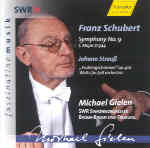Michael Gielen favors strictly proportional tempos in the first movement of Schubert’s “Great” C major symphony, with the result that the introductory Andante sounds faster than the ensuing Allegro, even though the latter moves at precisely twice the speed of the former. This wonderful aural illusion pays huge dividends in the coda, where the inevitable accelerando into the closing pages now sounds like a return to the original tempo of the opening horn tune. The playing sports fine textural detail and Gielen’s typically tight structural control, with expertly managed transitions between sections. I only wish that trumpets hadn’t been added to the return of that opening tune when it appears in the coda: the strident, “military” band solution to Schubert’s badly balanced scoring really does sound vulgar, even if it has become the commonly accepted solution today.
Gielen rips into the second movement with unwavering ferocity (it lasts less than 13 minutes), although it’s not the opening theme that proves surprising, but rather the swift second subject. It sounds marvelous played with such fluidity, and the big climax toward the end is terrifying. Unfortunately, Gielen honors a few too many repeats in the scherzo (especially its endless trio), making it much the longest movement in the symphony. I firmly believe that if you are going to do this sort of thing, then you have to take the exposition repeats in the first movement and finale as well, just to keep the proportions right. Fortunately, at these tempos, it doesn’t matter so much, and the movement’s outer sections certainly sound breezy. Also, Gielen isn’t afraid to let the trombones (here and elsewhere in the symphony) snap and snarl as Schubert no doubt intended.
The finale keeps up the already established feeling of urgency and goes like the wind, with snappy rhythms and some very focused playing from the violins in their endlessly repeated triplet accompaniments to the second subject. It’s typical of Gielen’s perceptive way with this music that in the coda, where most conductors lean most heavily on those pounding unison Cs, even to the point of holding back the music’s momentum, Gielen instead waits for the ferocious reaction, hammering home the trumpet triplets with real violence. The result must be accounted one of the fresher and more rewarding views of the symphony to come along in quite a while.
In his notes regarding the coupling, a charming and felicitous performance of Johann Strauss Jr.’s Voices of Spring waltz, Gielen admits both to his “dirty secret” in enjoying this composer, and to his occasional naughty desire to let his avant-garde down and have some fun. We forgive you, Maestro Gielen.
































